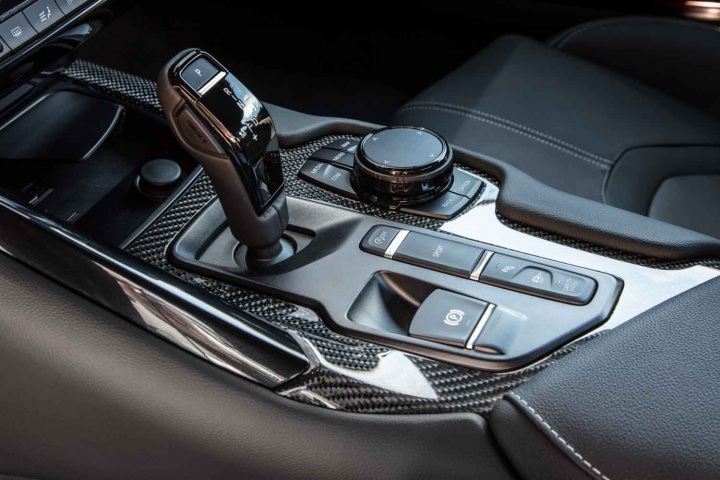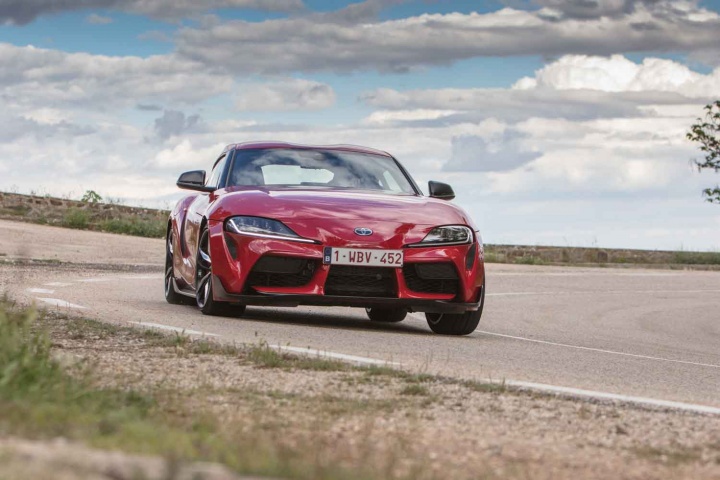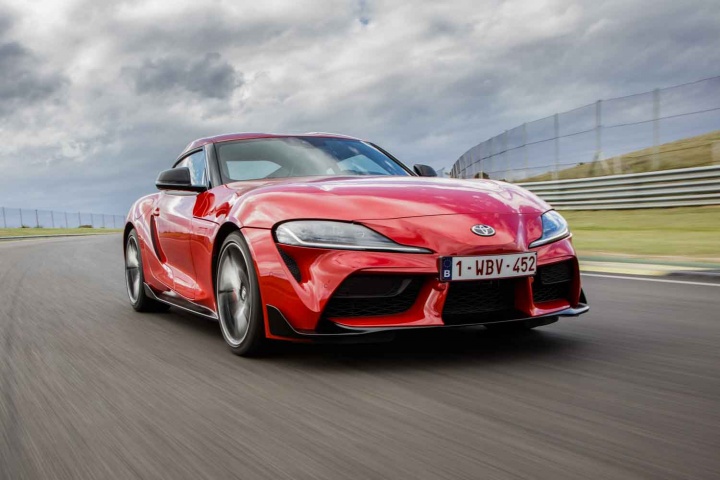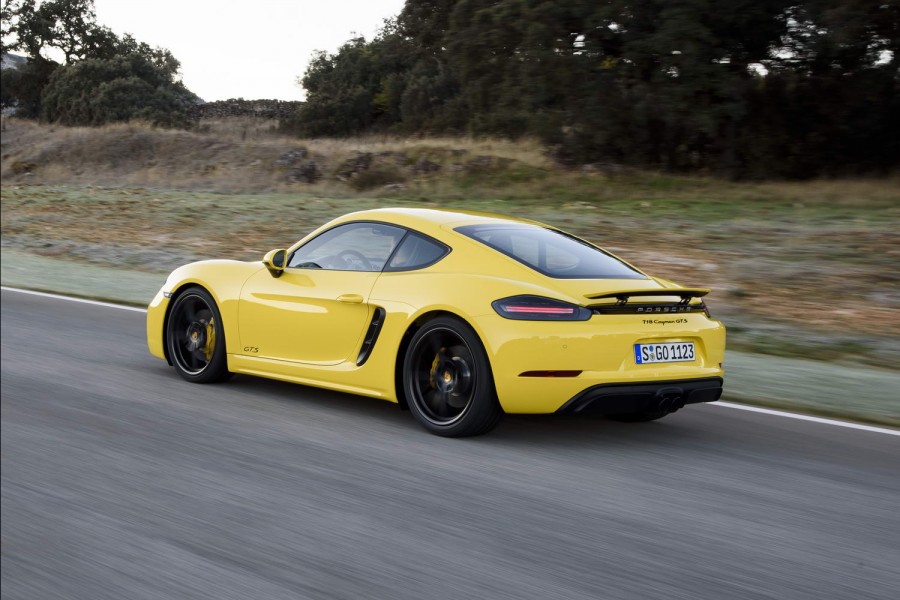Car enthusiasts have had to wait a considerable time for this new Toyota Supra to arrive. The name has a massive following with legions of fans, which meant enormous pressure for the development team. On name alone, few other sports cars carry as much weight of expectation on its shoulders as this one does. After a gap of seventeen years, we're finally driving a new Toyota Supra coupe.
In the metal
Cast your mind back to the 2014 North American Auto Show and the spectacular reveal of the Toyota FT1 concept. It was a first glimpse of what was to become the Toyota Supra. And it was good. But as is often the case with design concepts that go on to reach production, there had to be compromises, and the production version of the Supra has been watered down slightly. Nonetheless, photos don't properly convey the size and proportions of the Supra.
It's short, wide and bulges in all the right places. Park it next to a previous generation 'A80' Toyota Supra and you won't miss how the new model is shorter (by 136mm) and wider (by 43mm) than its predecessor, but it is also taller by 27mm. What might be of more surprise is that the new Supra's wheelbase is a significant 100mm shorter than the Toyota GT86's.
These dimensions were dictated by Toyota's partnership with BMW that led to the creation of this chassis in the first place. On the German side, it underpins the BMW Z4, and Toyota also takes in BMW's turbocharged 3.0-litre straight-six petrol engine, along with several internal electrical systems and parts.
Regardless, the Supra's shape turns heads. The number plate at the front hides the shape of the nose to an extent, but draw your eyes back along the sculpted bonnet over the rakish screen and Zagato-like double-bubble roof and you'll appreciate that it dramatically slopes away to the rear. If there was just one criticism to level at the Supra's appearance, it is the fact that all those vents you see sliced into the bodywork don't serve any purpose. Some on the Supra's development team admit that these may change when the car goes through its mid-cycle update in a few years' time.
After you ease yourself into the low-slung sports seats, you're presented with a cabin that's well laid out and mostly driver-focused. You don't have that incredible bank of controls that surrounded the steering wheel in the old A80 Supra (if you aren't familiar with it, it's worth looking up, as it's fantastic); instead, there's an 8.8-inch digital instrument display that curiously has a three-dimensional tacho placed over it, which somewhat restricts the range of graphics that the screen can offer. Nevertheless, it's clear and easy to read, while the optional large head-up display gives you what you need when concentrating on the road ahead.
A second 8.8-inch display stands freely on top of the centre console, and you can operate it via the same rotary controller that BMW uses across its range. The infotainment system itself is based on the excellent BMW iDrive system, but gets a subtle re-skin. The presence of this system is no bad thing, as BMW is one of the best in the business in terms of infotainment interfaces. Behind the seats, there isn't a bulkhead separating the 280-litre boot. That means that you will hear whatever you have in there moving around as you drive, but the upside is that it's easily accessible.
Driving it
Before delving into what it's like to drive the Supra, it's worth dwelling on the numbers involved. Remember those proportions and a wheelbase that's shorter than the GT86's? Now add perfect 50:50 weight distribution and torsional rigidity that is greater than that of the Lexus LFA. Fire the turbocharged 3.0-litre engine into life and it quickly settles to a deep, low idle. When asked about the most challenging elements of the Supra's development, Masayuki Kai, Assistant Chief Engineer for the car, admits it was getting the sound right. The noise regulations for Europe mean that the Supra we get here doesn't sound anywhere near as loud as the US models.
However, with 500Nm of torque on tap, there isn't any lack of pulling power from the BMW-sourced engine. That peak torque output is available from just 1,600rpm and lasts through to 4,500rpm, giving it a very usable mid-range. When driven casually in its standard setting the Supra gets up through the eight-speed gearbox quickly and is often in sixth gear before you know it. Toyota does use its own software for the ZF-sourced transmission, and while BMW makes this automatic gearbox work better than most other carmakers that use it, Toyota isn't far behind in how well it makes this unit shuffle cogs. Keener drivers may prefer to use the paddles behind the steering wheel, of course.
One of the best elements to the Supra's driving experience is the accurate and precise steering. From the moment you slide your thumbs in around the slim wheel, it feels right. There is a lovely amount of weight to it, requiring just enough input effort to affirm your connection with the car. Entirely usable as an everyday car, the Supra is as docile as you like in city traffic. There's even stop-and-go adaptive cruise control for the motorway commutes.
But you'll never want to drive this car on boring motorways. Get it on a twisting, undulating route, and it shows off just how precise that steering is. It's linear and delivers surgical precision that for the first few times you drive it hard makes you think 'Wow'. Toyota hasn't thrown a heap of artificial weight at the steering either, even in the Sport mode. And you have to push very hard before you even begin to get a hint of understeer creeping in.
That's partly thanks to the sticky Michelin Super Sport tyres that are wrapped around the 19-inch forged wheels, but throw a variety of corners at the Supra and it laps them up. It corners beautifully, exhibiting excellent body control, highlighting that immense torsional stiffness and super low centre of gravity. The Supra gives you confidence more than it flatters. It rotates through apexes sweetly and threading the car through a series of left and right bends makes this chassis shine. All Supras get an active differential aiding traction, especially on corner exit. Let that engine scream right up to its 6,500rpm redline and pull the right paddle to slot in the next gear. There is some sound augmentation through the car's speakers, but other than when the engine spins beyond 5,500rpm, at which point it sounds more digital or computer game-like, it generally sounds fantastic.
Helping the handling is a suspension setup that is firm and manages body movements very well. During harder cornering it loads up nicely and putting the Supra through rapid changes of direction helps reveal the stiffness of its construction. It isn't overly stiffly sprung either, meaning day-to-day commuting should be bearable.
Its large Brembo brakes can rapidly dissipate speed while giving you a good deal of pedal feel. Only when we took the Supra onto the Jarama race circuit, under very heavy braking, did we wish for better stopping power. Avid track day drivers will want to consider brake pad upgrades as a minimum, as longer sessions can see the brake pedal start to go long under heavy workloads.
What you get for your money
Toyota Supra buyers in Ireland will have the choice of two versions, starting with the GR Spec that will cost €81,260. With this, you get most of the main features that include LED Adaptive headlights with daytime running lights, a black Alcantara interior with an electrically adjustable driver's seat, memory function and seat heating for both seats. Auto folding door mirrors, keyless entry and engine start is joined by an 8.8-inch infotainment display with satnav and Apple CarPlay.
If you're after some more upmarket equipment, the Supra GR Premium grade, at €84,335, adds leather upholstery, a 12-speaker JBL Audio system, ambient lighting, a head-up display and a wireless charging pad for compatible smartphone devices.
All models come with a suite of safety and driver assistance systems that include adaptive cruise control with stop and go function, lane departure warning, blind spot monitoring, road sign recognition, rear-cross traffic alert, intelligent park assist with auto braking and a pop-up bonnet with active pedestrian detection.
Summary
We could make more of a song and dance about how much BMW DNA is in the Supra, as so many others have, but it's like comparing apples and oranges. The Supra is a coupe while the Z4 is a roadster. If we did have to choose, it is the Supra that's the better car to drive overall. It delivers sharp handling, a wonderful engine and, most importantly, it's exciting and fun to drive.











































